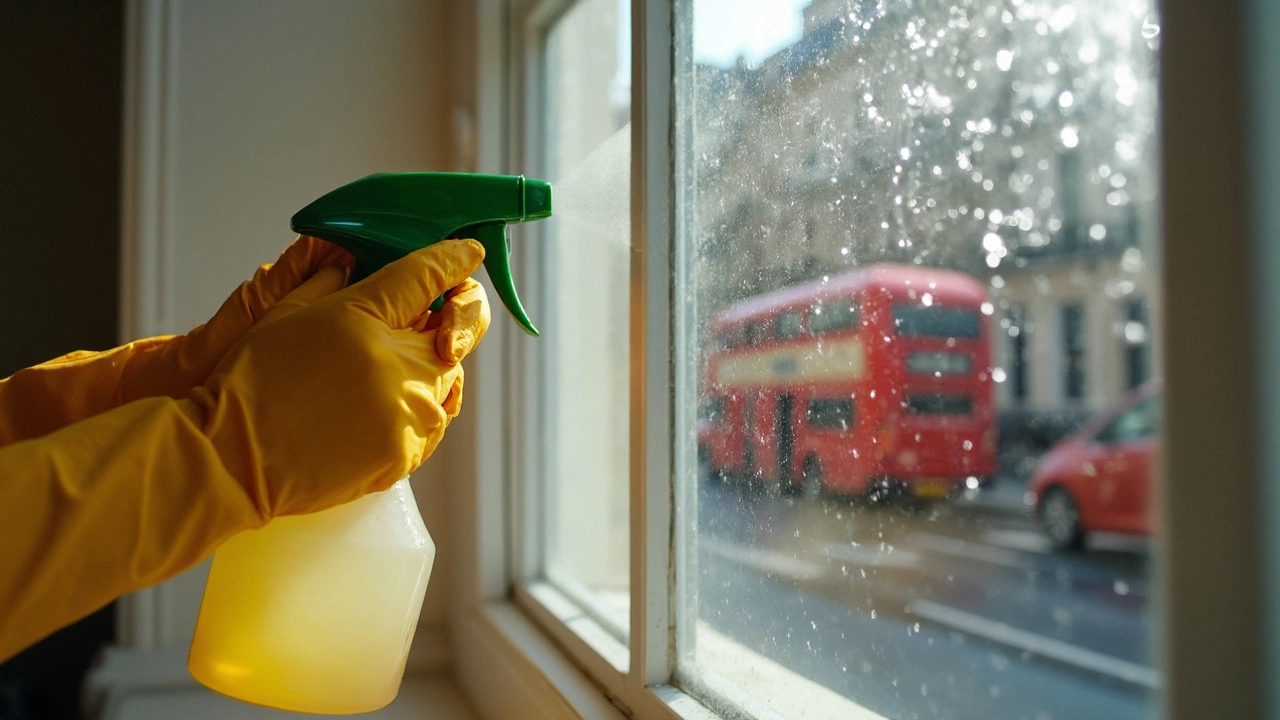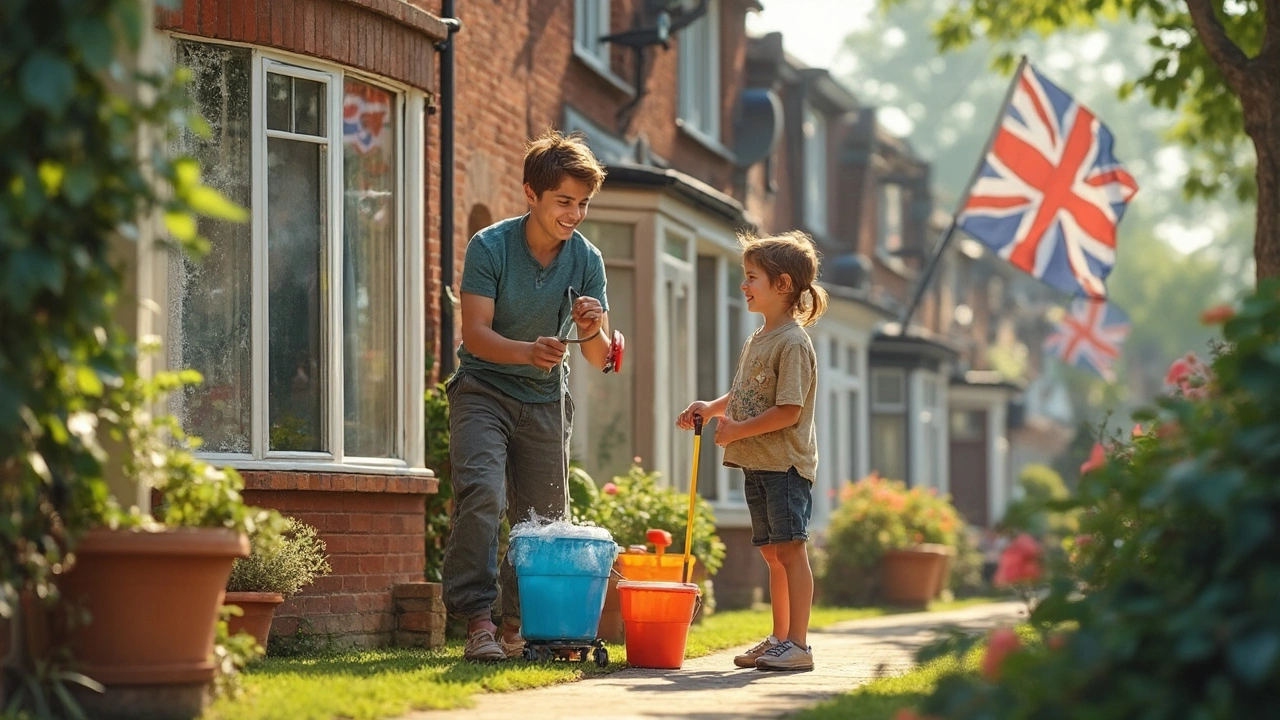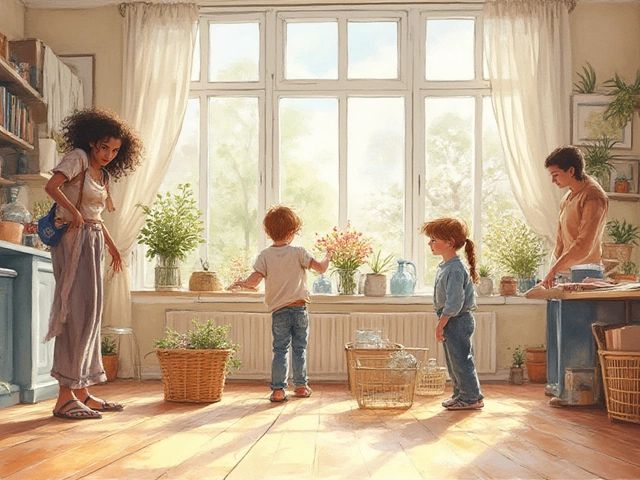No one likes staring through smudged or grimy glass, especially after putting effort into tidying the indoors. Keeping outside windows clean isn't just about looks — it can actually help your windows last longer and work better. But what’s the best way to get them really clean?
Surprisingly, you don’t need expensive sprays or magic wipes. A bucket, a soft sponge or microfiber cloth, some dish soap, and water can get you started. For really stubborn spots, a splash of vinegar in your cleaning mix does wonders. And if you’ve got old newspapers lying around, they’re perfect for buffing the glass streak-free. Just watch out for torn bits sticking to wet frames.
- Why Outside Windows Get So Dirty
- The Best Cleaning Solutions and Tools
- Practical Cleaning Steps for Sparkling Glass
- Tips for Higher or Hard-to-Reach Windows
Why Outside Windows Get So Dirty
You probably notice your outside windows always seem dirtier than the inside, no matter how tidy your home is. There’s a good reason for that: exterior glass deals with everything out there—dust, pollen, rain, smog, and even bird droppings. Unlike inside windows, these never catch a break.
Here’s what’s clinging to your windows:
- Dirt and Dust: Wind kicks up soil, dust, and construction leftovers, sticking them right onto the glass.
- Pollen: If there’s anything in the air during spring and summer, it's pollen. It sticks to wet surfaces after rain or morning dew.
- Hard Water Stains: Sprinklers or rainfall can dry and leave behind mineral spots that look especially ugly in the sun.
- Bird Droppings and Insects: Birds never care where they aim, and bugs leave those tiny splatters behind, too.
- Pollution and Smog: Living near a busy street? Exhaust and smoke leave a thin, greasy film that’s stubborn to wipe away.
Weather and location matter a lot. If you’re close to trees, traffic, or construction, dirt builds up faster. Here’s a quick look at what most windows face throughout the year:
| Source | How Often It Affects Windows |
|---|---|
| Rain & Hard Water | Every rainfall (year-round) |
| Pollen | High in spring/summer |
| Pollution/Smog | Worse near busy roads, constant |
| Birds/Insects | Random, but regular outdoors |
That buildup isn’t just ugly, either. Over time, all that grime can make the glass cloudy and even damage window seals. Tackling clean outside windows regularly keeps your home looking sharp and protects your investment.
The Best Cleaning Solutions and Tools
There are a ton of cleaning products out there, but honestly, nothing beats the basics for clean outside windows. Most pros still reach for soapy water and plain tools because they’re reliable and safe for the glass. Here’s what actually works best for stubborn outdoor gunk, dried rain spots, and the weird mystery streaks that always seem to appear right after you think you’re done.
For the cleaning solution, all you really need to start is:
- A bucket of warm water mixed with a couple drops of dish soap (go easy—too much soap makes rinsing harder).
- Add a half cup of white vinegar per two gallons of water if your windows have a cloudy haze or dried mineral spots.
- If you’re dealing with thick buildup or pollen, a store-bought window cleaner like Windex Outdoor or even diluted car windshield fluid can help, but save those for when homemade stuff isn’t enough.
What about the gear? Save your arms with the right tools:
- Microfiber cloths: Grab a few. They pick up dirt and don’t leave lint behind like paper towels.
- Soft-bristle brush: Good for scrubbing frames and sills before you touch the glass.
- Squeegee: This is the real game changer. Even cheap ones do a great job at getting the water and smears off without streaks.
- Extendable pole: For higher windows, attach your cloth or squeegee to this and keep your feet safely on the ground.
- Sponge or mop: For a first scrub if your windows are extra grimy.
According to the International Window Cleaning Association, “Using a squeegee with a sharp rubber blade is the fastest, most effective way to get windows streak-free.”
“A simple mix of water and mild dish detergent removes 95% of outside window dirt, even in city environments.” – International Window Cleaning Association
If you’re curious which method is popular, check out the numbers below:
| Cleaning Method | Effectiveness (percent of users satisfied) |
|---|---|
| Soapy water with squeegee | 92% |
| Commercial spray cleaners | 74% |
| Vinegar and water mix | 85% |
So skip the fancy stuff unless your windows need serious help. With these tools and solutions, you’ll get outdoor glass that looks clear enough to make your neighbors ask what your secret is.

Practical Cleaning Steps for Sparkling Glass
Let’s walk through cleaning outside windows so you don’t end up frustrated halfway through. Having a good plan saves time and gives better results every single time.
- Pick the right day. Aim for a cool, cloudy day—direct sunlight can dry the cleaner too fast and leave nasty streaks. If it’s windy or rainy, save the job for later.
- Brush off loose dirt first. Dirt, spider webs, and leaves can all scratch your glass if you go in with a wet sponge first. Just brush everything away gently with a soft broom or dusting cloth.
- Mix your cleaning solution. Use a bucket of lukewarm water with a few drops of dish soap—just enough to cut through grime. If the glass is extra dirty, add a cup of white vinegar to the mix.
- Wipe each window top to bottom. Dip a microfiber cloth or soft sponge in your solution and go over the glass in straight lines. Hit the frames, too—they collect more gunk than you think.
- Rinse with clean water. Fill another bucket with plain water and wipe the window again to clear off any soapy residue.
- Dry for a streak-free finish. Use a rubber squeegee, going from top to bottom in one smooth motion, wiping the blade after each pass. No squeegee? Dry with a clean, lint-free cloth or crumpled newspaper—but only if the ink is soy-based so you don’t leave smudges.
If your window screens look grimy, you can pop them out and hose them down separately, letting them air dry before reinstalling. This makes a surprising difference in how clean the glass looks afterward.
For super tough water spots or mineral stains, there’s no need to get fancy. A paste of baking soda and water applied with a soft cloth can work on stubborn spots. Just don’t scrub too hard, or you’ll scratch the glass.
Here’s a quick data table showing which cleaning methods folks say work best for each type of outside window mess:
| Problem | Best Tool | Best Solution |
|---|---|---|
| General Dirt & Dust | Microfiber cloth, squeegee | Dish soap + water |
| Bird Droppings | Soft sponge | Vinegar + water mix |
| Pollen & Tree Sap | Plastic scraper, cloth | Baking soda paste |
| Water Spots | Soft cloth | Vinegar soak, then plain water |
The most important thing? Be patient. The first window usually takes the longest, but once you get into a rhythm, it goes way faster. If your windows are really high up or hard to reach, don’t risk it—safety matters more than perfect streak-free glass. Get a sturdy ladder or consider calling in a local pro for those spots.
Your reward for a little effort is that crystal-clear, clean outside windows look that lets in way more light and makes everything feel fresher at home.
Tips for Higher or Hard-to-Reach Windows
Cleaning those upper-story windows is where people usually throw in the towel—literally. The good news? You don’t need to risk your neck on a rickety step stool. The smartest move is picking the right gear and knowing a couple of clever tricks.
Extension window cleaning poles are a game-changer. You can grab one that extends 12 to 24 feet. Attach a microfiber pad or squeegee, dunk it in your cleaning mix, and get to work from the ground. Some poles even hook straight up to your garden hose so rinsing is quick.
If you’re facing stubborn, caked-on dirt or bird droppings, let your cleaner soak for a few minutes. Don’t scrub hard and risk scratching; just go over it a couple of times. For windows that tilt in, cleaning is obviously easier. Just fold them into your room or hallway and follow your usual routine.
- Use a clean outside windows solution with a very soft-bristled brush for dirt in tricky spots.
- If you’re dealing with a multi-story home, never lean out of windows or climb a ladder alone. Statistically, household ladder accidents result in nearly 90,000 ER visits each year in the US, most happening during outdoor chores like window cleaning.
- Consider a window cleaning kit with hose attachments—these often come with soap-dispensing heads so you can spray, scrub, and rinse in one go.
- For windows you absolutely can’t reach, there are water-fed pole systems that use purified water, which helps prevent spots and streaks.
| Tool/Method | Average Reach (feet) | Best Use |
|---|---|---|
| Extension Pole (Manual) | 12-24 | Standard second-story windows |
| Hose-Attached Squeegee | Up to 20 | Large, wide panels |
| Tilt-In Window Feature | N/A (indoor use) | Modern sliding windows |
| Ladder (with spotter) | Variable | Only when absolutely needed |
| Water-Fed Pole System | 30+ | Very high or commercial windows |
One last tip: Pay attention to your safety. Always work with someone around if you have to use a ladder, and double-check it’s stable. If it feels iffy, don’t risk it—just call a professional. Your windows will still be there tomorrow.





